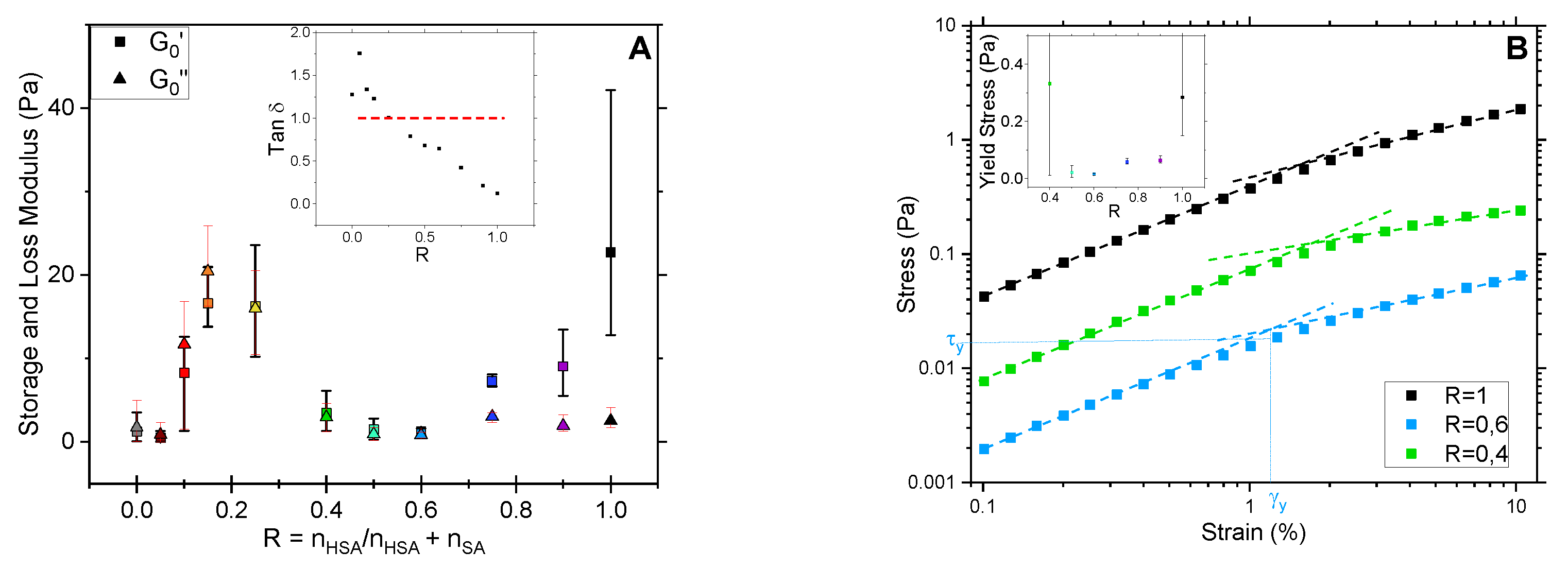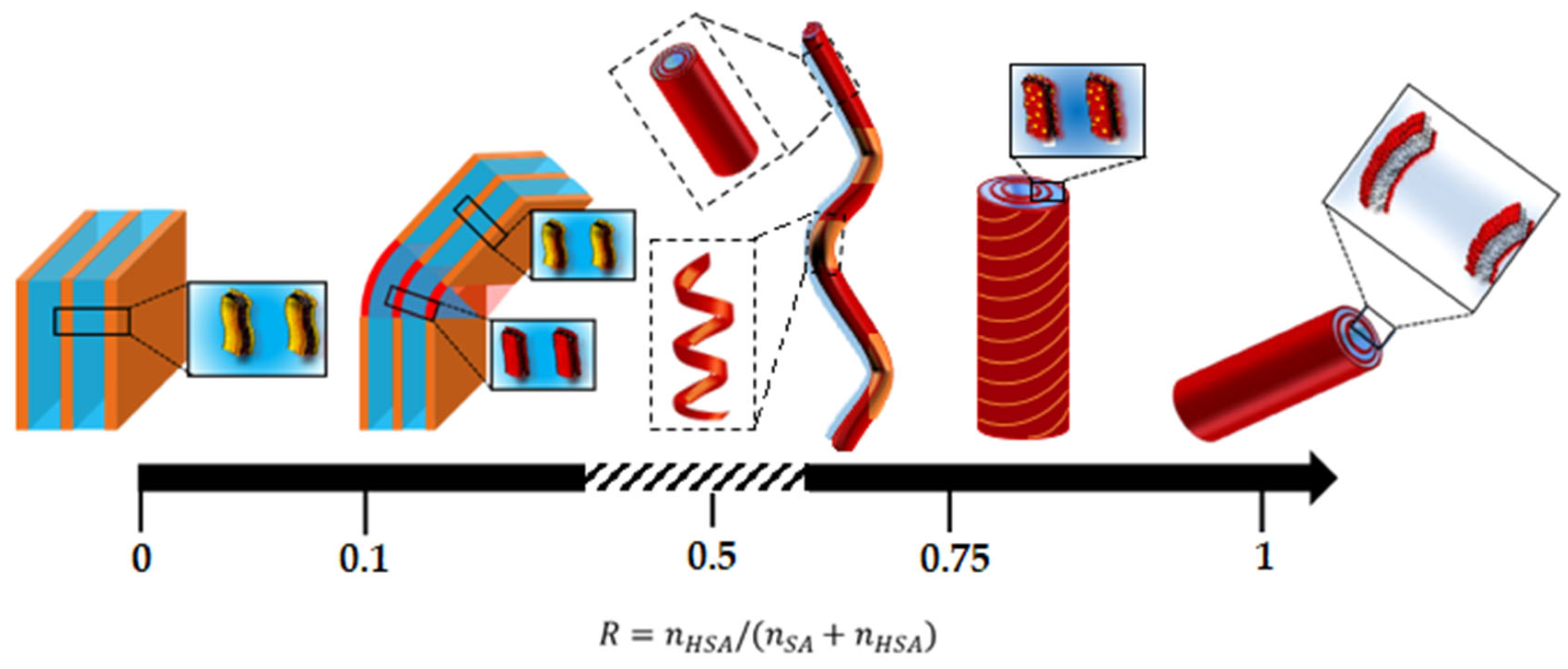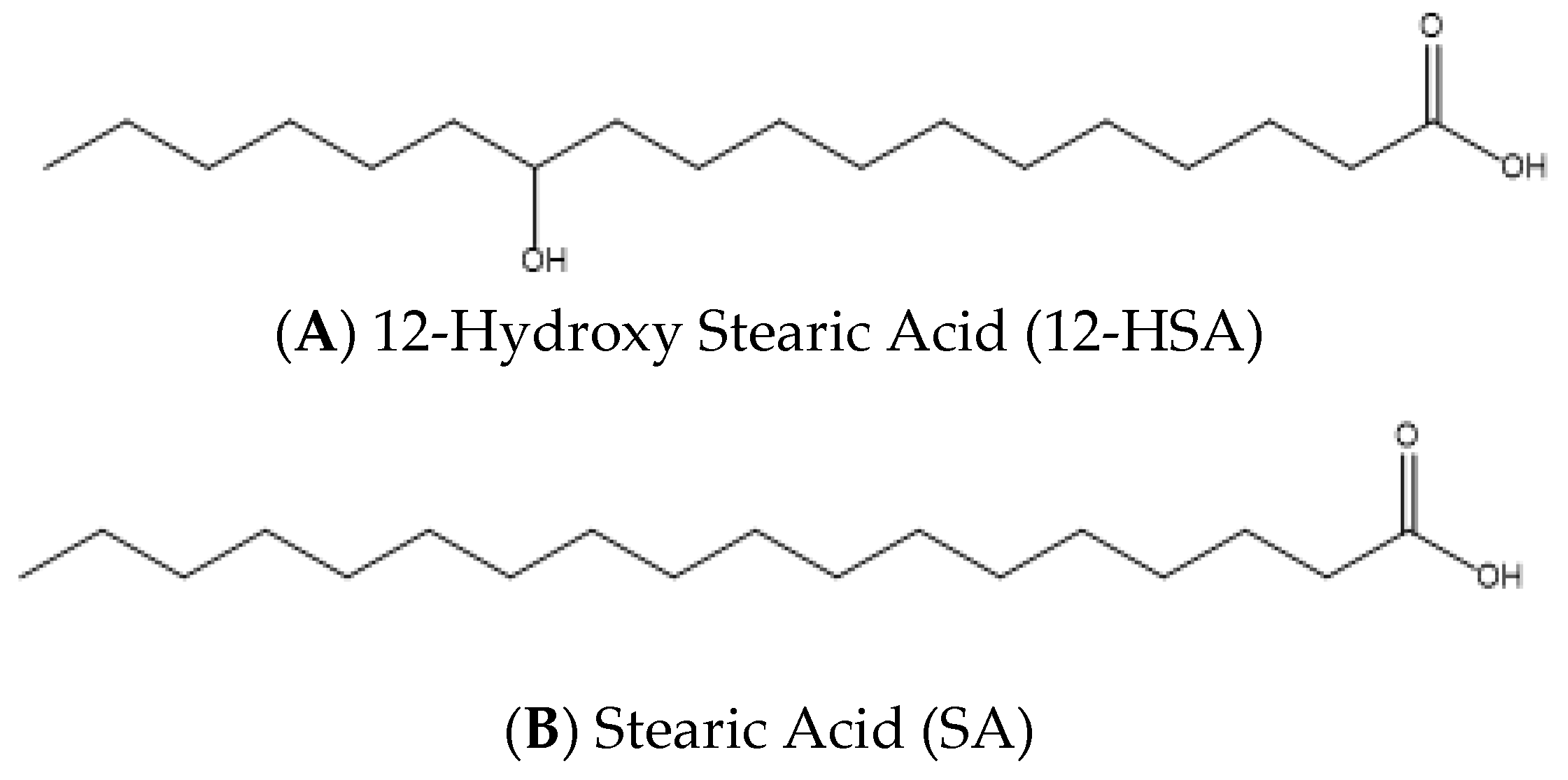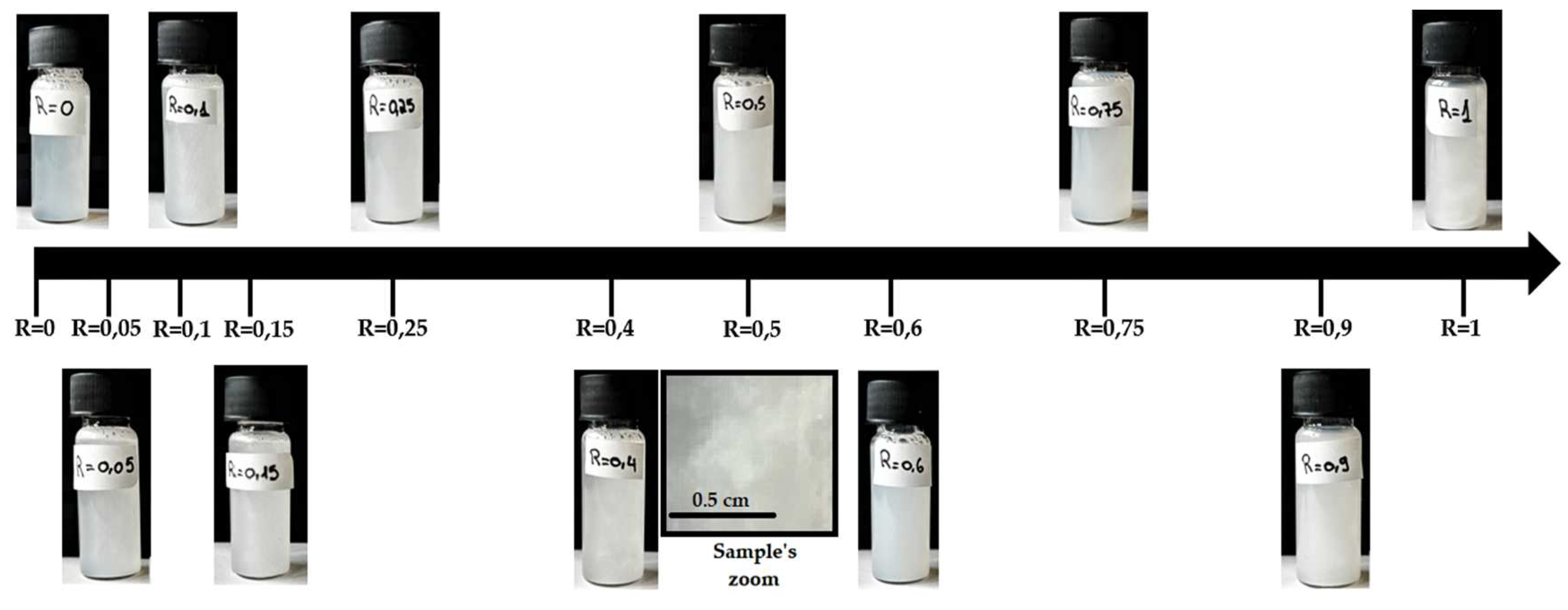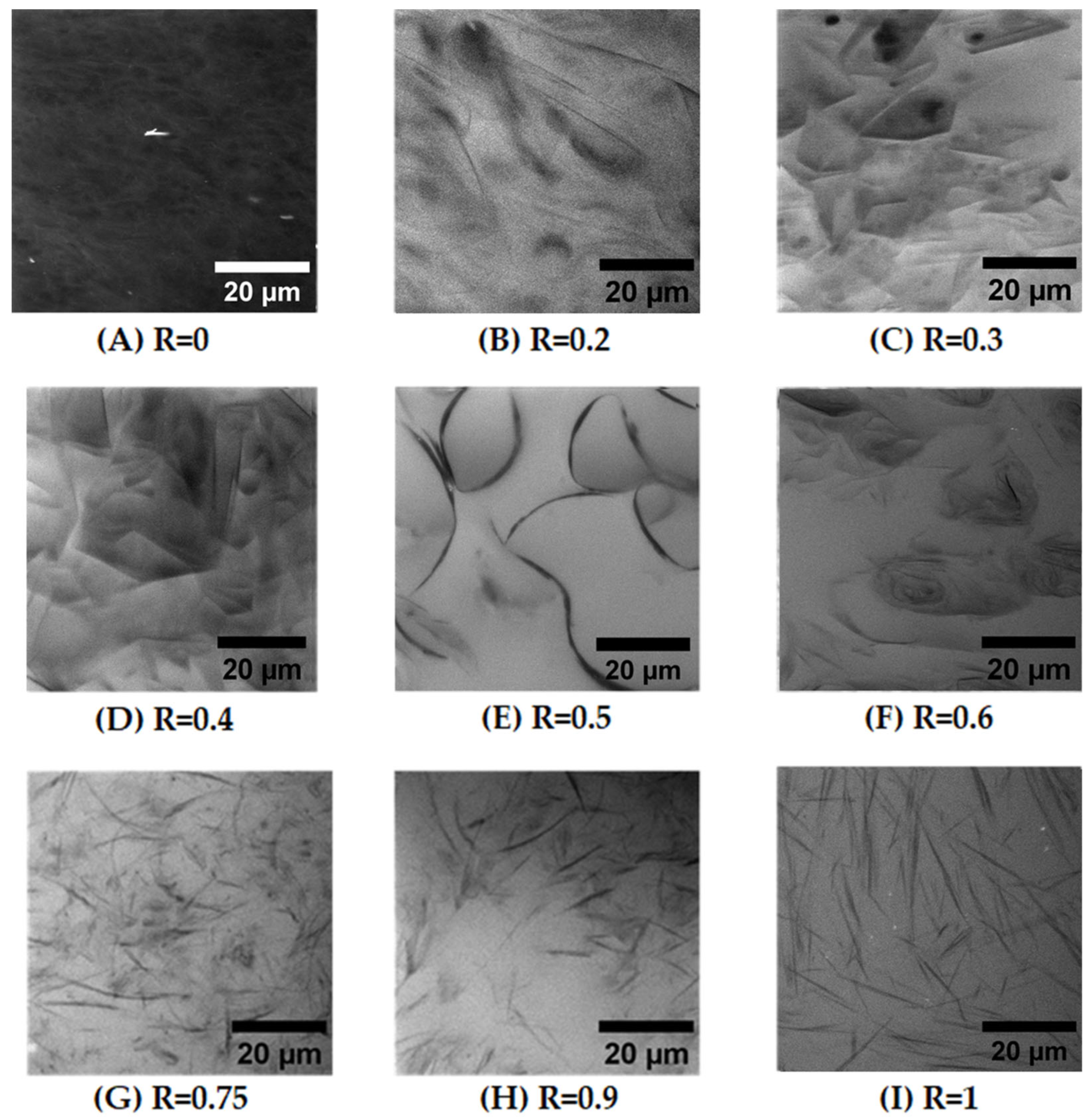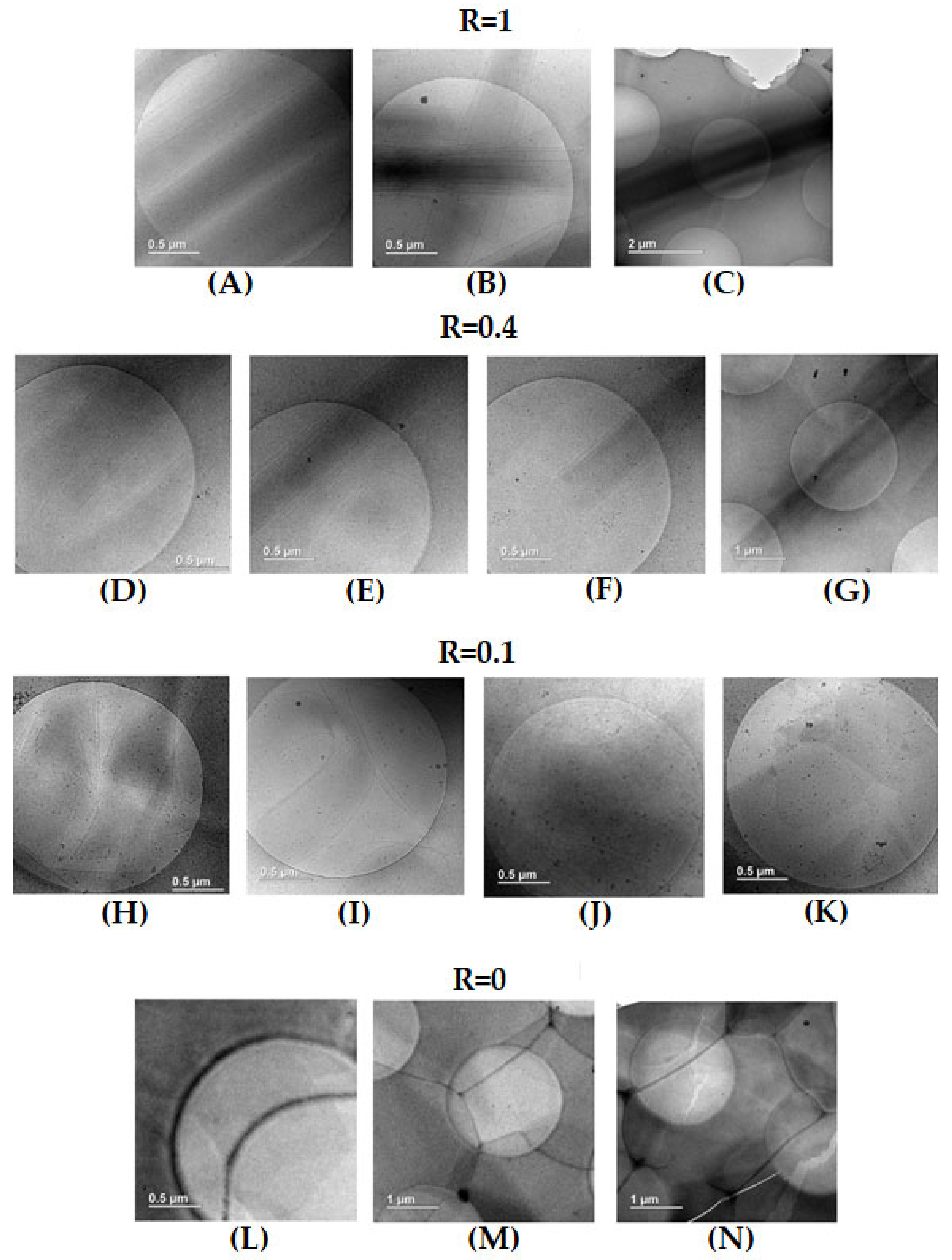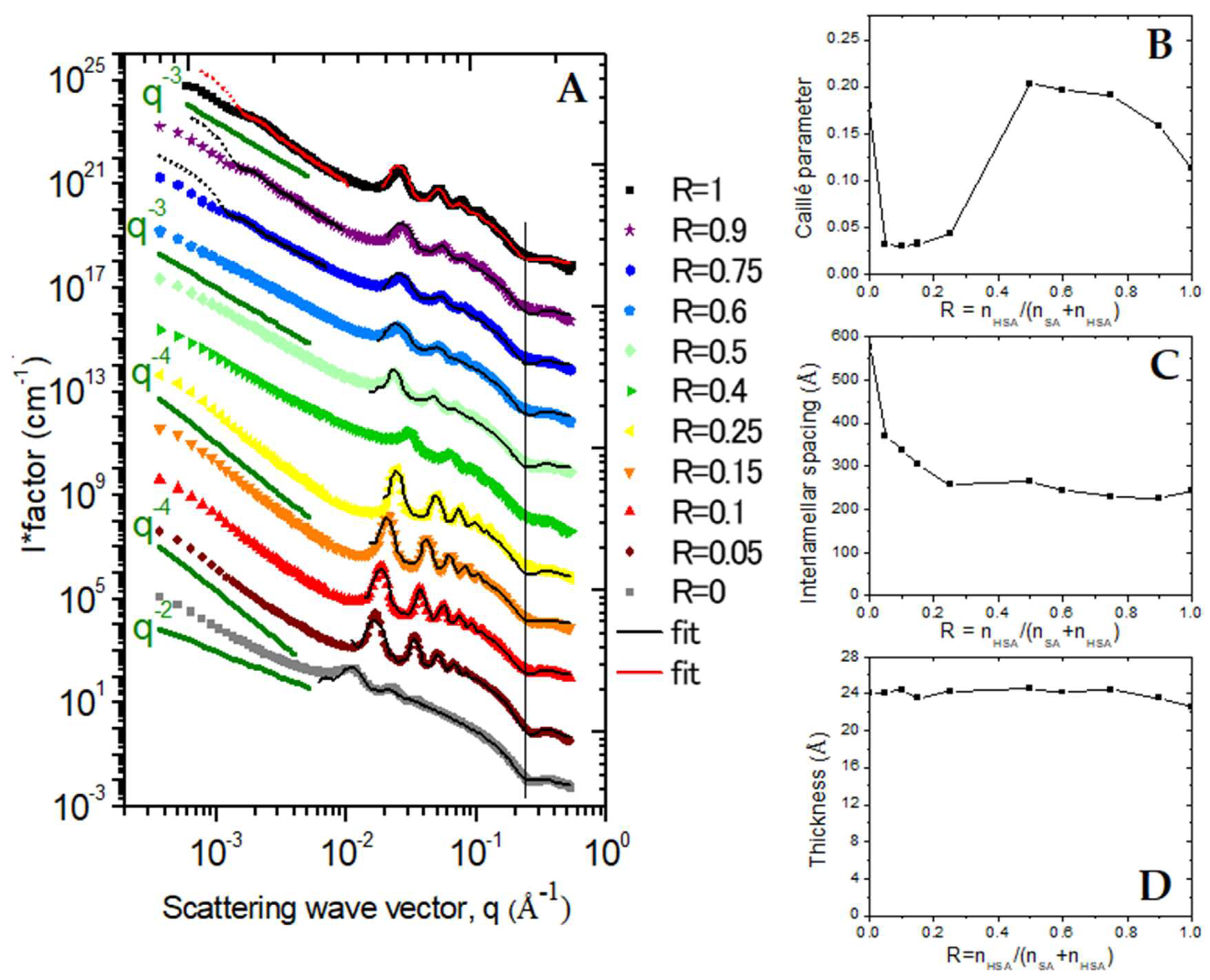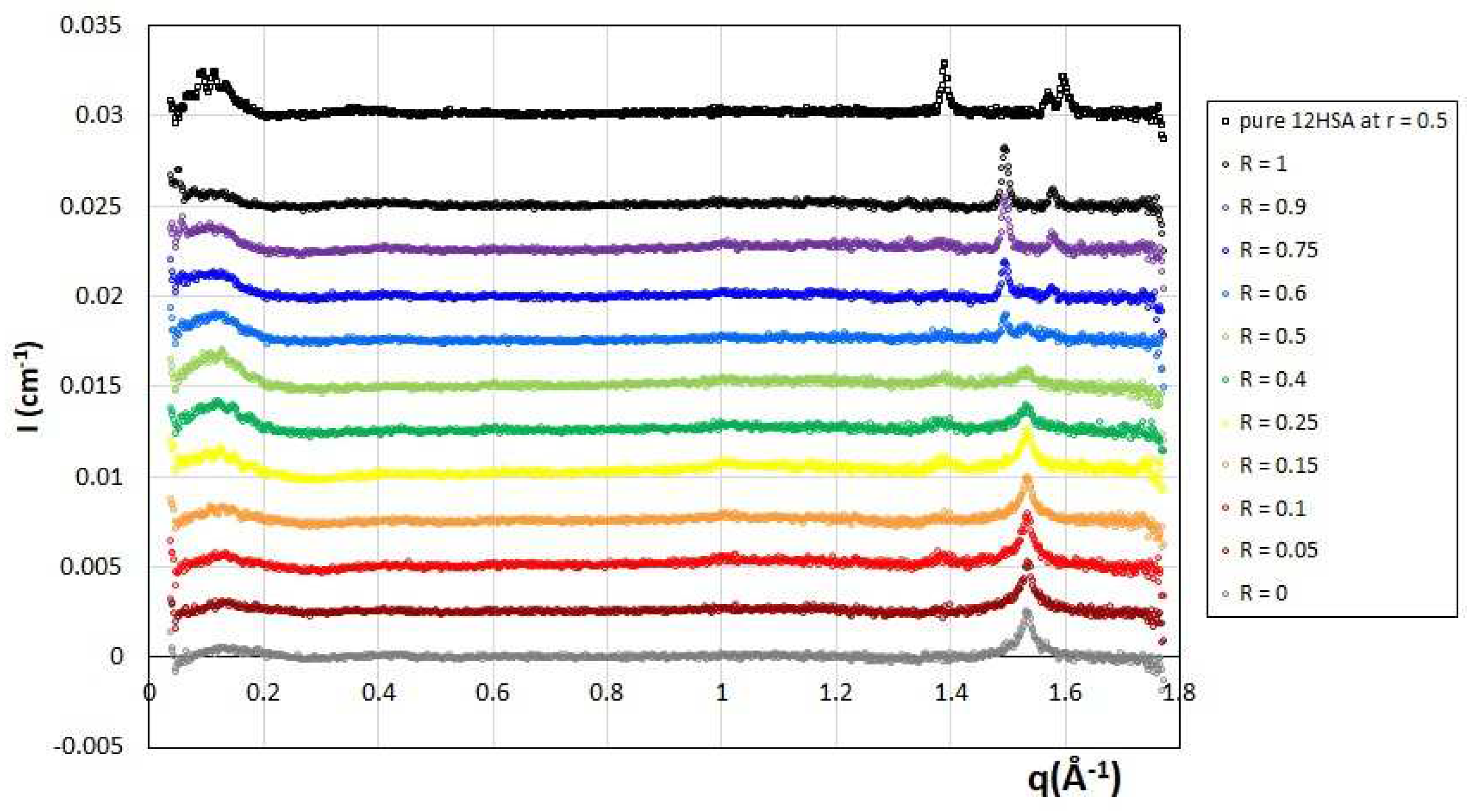2.2. Confocal Microscopy
Confocal microscopy of samples has been performed on the whole range of ratio R using a hydrophobic dye, Nile Red. The Nile Red concentration is negligible with respect to the fatty acid concentration (see Materials and Methods), so that we assume that the morphology of the self-assembled structures is not modified by its introduction.
Figure 3 shows some representative images of samples for all R probed with a ×100 objective. On the images, the black domains are enriched in Nile red, and correspond thus to the hydrophobic regions of the self-assembled structures made of the alkyl chains of the fatty acids, whereas white domains do not contain the fluorophores.
Figure 3I shows the image obtained for R=1 (pure HSA) that reveals the presence of disordered thin and rigid rods with a length of around 20 μm. These rods corresponds to the multi-lamellar tubes resulting from the self-assembly of HSA molecules. [
39] The organization of these tubes appears disordered, without formation of any nematic order. When R decreases from 1 down to 0.75 upon the introduction of a small amount of SA (
Figure 3H,G), the self-assembled structures conserve their rodlike shape. It however appears that the overall length of the rods decreases progressively, with a distribution of lengths that becomes more polydisperse, when R decreases. We did not make a statistical study of this variation of tube length in this regimes of large R because images are transversal cross-sections of a 3D sample.
At R = 0.75, it also appears that a very small amount of curved objects coexist with the long tubes. This trend is confirmed when decreasing R in the regime of intermediate R (R=0.6, R=0.5). Indeed, for R=0.6 (
Figure 3F), the rigid thin polydisperse rods now coexist with an important amount of objects with a large curvature. For R=0.5, at stoichiometry, fatty acids self-assemble into bended long tubes that can reach much longer length that the 20 μm obtained at R = 1 and extend up to 60 μm (
Figure S1E). These bended tubes appear to be made of two types of domains, with some rigid parts bound to each other by some curved parts. In this regime of intermediate R, the structure of fatty acid self-assemblies evolves thus continuously from bended tubes to rigid ones with R. In their seminal study where they introduced an important amount of SA in aqueous solutions of 12-HSA, Fameau
et al. [
11] observed by phase contrast microscopy the formation of twisted ribbons that are the precursors of multilamellar tubes. Confocal microscopy does not allow to discriminate between multi-lamellar tubes and ribbons, however we hypothesize that the rigid parts do correspond to the tubes and the bended ones to ribbons.
At low R, where SA is in excess, the structure is completely different and images are less simple to interprete (see
Figure 3D,
Figure 3C and
Figure 3B that correspond respectively to R=0.4, R=0.3 and R=0.2). There are no longer thin black lines in which all Nile red hydrophobic molecules concentrate, as it was for larger R, but 2D domains of variable levels of grey. Most of these domains have straight sides, suggesting the formation of facetted objects, connected to each other by either edges or by curved parts. Some other domains display a more spherical shape. These domains are all made of multi-lamellar bilayers, as demonstrated by SANS as we will show later. They have thus different distributions of thicknesses and orientations, which give rise to this variation of grey level from one domain to another. The fact that the majority of their sides are either straight or circular suggest that they are made of planar lamellar phases connected by spherical lamellar phases, that are possibly pieces of multilamellar tubes. The images also suggest that these domains are strongly entangled. Indeed, when following the temporal evolution of the system during the experiment, it appeared that these domains do not move individually but collectively (data not shown). This collective motion of domains is consistent with the fact that they are either connected to each other and/or strongly entangled.
Finally, for R=0 (pure SA), there are only small fluctuations of the color of the images, with a typical size of fluctuations of the order of a few microns, although SANS experiments shown later will unambiguously demonstrate that this sample contains planar lamellae. Since all lamellar phase domains contain the same amount of fluorophores in average, the only variations of grey level within the images come from orientation of the 2D lamellar domains. The image is thus consistent with a structural organization of planar lamellar phase domains with random orientations that occupy all space, in agreement with literature. [
15]
2.3. Cryogenic Transmission Electron Microscopy (Cryo-TEM)
Pictures of samples were obtained by Cryogenic Transmission Electron Microscopy for pure HSA (R = 1), pure SA (R = 0), intermediate content of both kinds of molecules (R = 0.4) and low content of SA (R = 0.1). Samples were left at room temperature (around 20°C) for 24 hours to equilibrate before the freezing step. The final thickness of the frozen cut sample is around 1 micrometer, which is much lower than the length of the tubes of the order of 20 μm observed by confocal microscopy. This forces them to lay onto the grid surface.
For R=1, long straight rectangular objects are visible with a width of ~ 500 nm and a length that is at least 8 μm, as they exceed such a size that corresponds to the image section at the lowest magnification probed, in agreement with the length of 20 μm determined by confocal microscopy (
Figure 4A–C). In all of these rectangles, there is a continuous gradient within the grey scale from the outer of the edges of the rectangle that are lighter to the inner of the rectangle that is darker, evidencing a continuous variation of their thickness from outward to inward. Even if the images are 2D, this demonstrates that these rectangular shapes do correspond to cylindrical tubes. There are some parallel dark lines within the tubes parallel to their edges, which originates from the presence of lamellas. Although SANS experiments demonstrate that the inter-lamellar distance is constant (see later), such a distance between lamella does not appear strictly constant on images, but this is an effect of projection from the 3D self-assemblies to the 2D images. Moreover, the dark center of the rectangles tubes does not show any lamella. This is also consistent with the formation of multi-lamellar tubes, as such a dark center corresponds to the top of adsorbed cylinder where lamella are parallel to the surface. Thus the exact estimate of the number of lamella is not possible from these cryo-TEM images, yet they reveal that there are at least 5 or 6 lamella per tube. Since the tubes lay onto the surface, there are no images of the section of the tubes, but they would resemble to onions. Similar pictures have been obtained by cryo-TEM on multi-lamellar tubes of SDS@2β-CD. [
42] In summary, these cryo-TEM images are fully consistent with the structure proposed in literature for HSA self-assemblies as long rigid multi-lamellar tubes. They also evidence that the radius of these tubes are rather monodisperse, since their width is fairly constant from one tube to another. But the more interesting feature concerns their ends, which are open and not capped, as it is unambiguously visible in some pictures (
Figure 4B). This was not established yet in literature.
For pure SA (R=0), while turbidity and SANS (see later) unambiguously demonstrate that large lamellar self-assembled aggregates do exist in solution, they are not visible at first sight on the grid. There are areas domains, with various size, that are more or less dark separated by straight edges that must correspond to steps between domains of different thicknesses (
Figure 4L,M). Such areas come from the coverage of the surface by surfactants molecules, as proven by the presence of cracks, that are depleted in molecules since their light grey level corresponds to the pure grid, as shown in
Figure 4N. It is likely that planar lamellar phases with a variable number of lamellae, but probably low, are deposited on the surface and lay parallel to it. The images are thus a top view of such lamella and the steps correspond to a change of lamellas number from one domain to another. The darker the area, the larger the number of lamella. Similar pictures have been also obtained by cryo-TEM on Lα lamellar phase on fatty acids in excess of alkali. [
15]
For R = 0.4, there are also long rigid multi-lamellar tubes with open ends, as for the R= 1 case with the same order of magnitude of radius (
Figure 4D–F) and a length that still exceeds 10 microns (
Figure 4G). However, compared to such R = 1 case, the number of lamella seems to be slightly reduced in average, and varies more largely from one tube to another. It also appears that parts of the tubes are slightly curved. This is in line with what was observed by confocal microscopy at R = 0.5 with long 1D objects with rigid and soft domains. This suggests that part of the objects evidenced by cryo-TEM are twisted ribbons and not multilamellar tubes, although the cryo-TEM images do not allow to arbitrate between both structures as they give the same image due to projection. The curved parts would come from the lowest rigidity of the ribbons.
For R = 0.1, there are no longer multi-lamellar tubes but the images still reveal the existence of lamellar structures with different morphologies and various number of lamella. The most striking feature concern the curvature of these lamellar, as they appear either straight, that may account for planar lamella or pieces of large tubes, or spherical, suggesting truncated onion vesicles (
Figure 4H,J). Such straight and spherical lamella eventually merge to form a single multi-lamellar objects (
Figure 4I). Regarding the number of lamella, it is ranging from a single lamella up to a few ones with the same order of magnitude as the tubes at R = 1. Also, part of images show the dark areas and steps, revealing the presence of planar lamellas sitting onto the surface, as for the R = 0 case (
Figure 4K). The samples are thus composed of different kinds of self-assemblies that partially fuse with different curvatures. It is thus likely that these different kinds of self-assembled aggregates do not all contain the same amount of SA and HSA molecules, i.e. there exists a partitioning between the two surfactants at the local scale.
2.4. Structure at Local Scale by SANS
The structure of self-assembled surfactants was determined by SANS in the whole range of R (
Figure 5A). SANS probes a range of distances from ca. 10 Å to 1 µm in solution, with no artifact from deposition on a 2D surface, and no addition of an extra probe; it does require to work in heavy water D
2O to create a contrast with the hydrogen-rich molecules and to decrease the large incoherent scattering of [
1] H, that acts as a constant background for SANS. Data are presented as intensity versus q, the magnitude of the wavevector, expressed in reciprocal length scale. In a first approximation, intensity-features at a given q-value can be associated to characteristic dimensions
d based on the Bragg relation
d~2π/q.
The SANS scattering spectra of the pure SA sample (R = 0) display all the characteristic features of a 2-D lamellar phase : (
i) a q
- [
2] scattering decay in the low q region, typical from the scattering of a 2-D object and that accounts for the planar shape of lamella, (
ii) a strong correlation peak at q
0 = 0.0109 Å
- [
1] followed by its harmonics at n·q
0 (n=2, 3, 4…) that accounts for the Bragg peak associated with the interlamellar distance
dinter whose order of magnitude is ~ 575 Å (2π/q
0) and (
iii) a so-called form factor oscillation at around 0.25 Å
- [
1] originating from the cross-section of the lamellae and enabling to determine its thickness at ~25 Å (2π/0.25). Such scattering spectra unambiguously demonstrate that the sample is made of lamellar phase in agreement with previous results from [
14] that deduce the formation of a lamellar phase by birefringence measurements, even if they are not visible on the cryo-TEM pictures.
The pure HSA system (R = 1) also displays the characteristics features of lamellar phases at intermediate and large q, (i.e. a correlation peak followed by its harmonics, oscillation at large q). It however immediately appear that interlamellar thickness is strongly reduced compared to the pure SA case and interactions between lamella are different from the pure SA case since q
0_R=1 is strongly shifted towards low q with respect to q
0_R=0 at ~ 0.025 Å
- [
1] (
dinter = 240 Å). The correlation peak is narrower, its harmonic being visible up to 6
th order, indicating a more regular periodicity, i.e. bilayers fluctuate less in the R = 1 case and/or comprise more stacked bilayers in tube wall than those forming the SA lamellar phase. The thickness of the lamella is similar to that of the pure SA case since the form factor oscillation is also at 0.25 Å
- [
1] . The main difference to the SA case appears in the low q region where the overall scattering decays overall like q
- [
3] and no longer as q
- [
2] , and shows a well-defined marked oscillation at 1.2 10
- [
3] Å
- [
1] , that comes from the form factor of tube diameter. The highlighting of such an oscillation was made possible by the extended low q range of the D11 diffractometer and was not yet reported on the scattering curves of the same system in literature as they were all limited to a reduced q-range. The overall q
- [
3] decay has however already been obtained on the scattering of hollow tubes and multi-lamellar tubes on other systems. [
42,
43,
45,
52] Assuming that tubes are rigid, such q
- [
3] can be explained by a decoupling approximation from a tube in its length (∝ 1/q) by its 2-D discotic section (∝ 1/q [
2] ). In the case of an imogolite hollow tube, Paineau et al [
52] , proposed to fit the scattering form factor by
, where Δ
ρ is the difference in scattering density between the tubes and the solvent, R
ext and R
int being respectively the external and internal diameters of the hollow tubes, and F the Fourier transform of the projection or a full cylinder of radius R along its axis
, with J
1 the first-order cylindrical Bessel function. The extension to orientationally averaged multilamellar tubes was proposed in reference [
45] for the fitting of scattering of multilamellar tubes made of SDS@2Β-CD complexes. It is here difficult to fit by such a model because the number of lamella is unknown. We have then fitted the low q part of the scattering spectra with a model of hollow tube with a single bilayer of fatty acids which allows to fit the minima and to recover the q
- [
3] decay (
Figure 5a). The tube radius R
tube was estimated at 200 nm. Such model however overestimates the intensity in the very low q part of the spectra with respect to the experimental data. This is due to the high scattering intensity in this very low q region at ~ 10 [
6] - 10 [
7] cm
- [
1] resulting in multiple scattering events that lower in practice the experimental measured pattern from its true value.
For the other R probed, the SANS scattering evidence the formation of lamellar phases in every case, yet several regimes can be clear-cut evidenced.
In the regime of low content of SA molecules for which rigid tubes were observed in confocal microscopy (1 > R ≥ 0.75), the scattering spectra are very similar to those of the pure HSA system at R = 1. The oscillation arising from the form factor of the tube radius and an overall q
- [
3] scattering decay at low q, the correlation peak of the interlamellar phase and its harmonics are around at the same positions and their amplitudes and width have the same order of magnitude. The mixture of molecules self-associate thus into multi-lamellar tubes that have a very similar structure as for the pure HSA system, revealing that these tubes can accommodate a significant amount in SA molecules. These SA molecules insert themselves within the HSA self-assemblies without disturbing the structure of the tubes. The tube radius increases slightly with respect to the R = 1 case at 210 nm for R=0.9 and 250 nm for R=0.75.
At intermediate R, for R = 0.6 and R = 0.5, all of the scattering features of multilamellar tubes are recovered, except for the low q oscillation of the tube form factor that is no longer present, the scattering decaying like q
- [
3] over the whole probed low q-range. It this thus likely that the distribution of the outer diameters of the tubes become very broad, which leads to the disappearance of the oscillation. This likely comes from the fact that the self-assemblies are made of both multi-lamellar tubes and twisted ribbons, the respective rigid and soft domains of the tubes observed by confocal and cryo-TEM microscopies, in agreement with reference [
11]. Even if the interlamellar distance is well defined, it is also possible that both rigid and curved domains do not contain the same amount of lamella, as it depends on the degree of rolling of the lamella into the ribbons.
At R = 0.4, the behavior is different. Although the scattering features are similar to those of the intermediate R case, the correlation peak and harmonics are strongly attenuated and shifted towards larger q, which evidences that interactions between lamella within tubes are largely different for such R. It has however to be kept in mind that samples partially phase separate at the macroscopic scale for such R and that the two phases are present in the measurement cuvette, since it has been filled from an homogenous solution at 70°C that has been cooled down. Given that the neutron beam illuminates both phases (with a beam cross-section near 1 cm
- [
2] ), it is thus difficult to go deeper in the SANS analysis for such a sample.
For R ≤ 0.25, at large content in SA molecules, the scattering curves markedly differ from the other cases. First, the correlation peak and its harmonics are much narrower than in the other cases, evidencing either stronger repulsions between lamella leading to a more regular periodicity, or a larger number of lamella per stack. Second, the scattering decays like q
- [
4] in the low q regime and no longer like q
- [
3] , even if cryo-TEM images show that there are still tubes in sample. This is the regime where confocal microscopy shows facetted objects and cryo-TEM straight rigid lamella and spherically curved lamella joint to each other. Neutrons interact thus with surfaces of very different orientations within the typical scale of the coherence length of neutrons (a few micrometers), which enables to recover the q
- [
4] Porod law. We postulate that in this regime where SA molecules are in excess, there is a partitioning between the two types of surfactants within the self-assemblies with 2-D lamellar phases of SA that are capped by partial pieces of vesicles (unilamellar or multilamellar) made of HSA molecules.
These first qualitative descriptions pointed out that there is a large evolution of the broadening of correlation peaks as a function of R. This may come either because bilayers fluctuate with different amplitudes or because the amount of stacked bilayers in the tube walls/lamellar phase changes. In order to get a refined quantitative description, all scattering curves in the intermediate and large q-region were fitted by a model proposed by Nallet
et al [
53] that considers a form factor of the lamella and a structure factor between lamella; both the number of stacked bilayers N
lam and the Caillé parameter (η) were adjusted accounting for the thermal fluctuations of the bilayers. Such a model allows us to determine the structural parameters of lamella (thickness, d-spacing
dinter, rigidity from the Caillé parameter). η is essentially determined from the region of the spectrum where the Bragg peaks arise at intermediate q and the thickness of the lamella from the oscillation at large q, which enables us to decouple these parameters rather confidently in the fitting process. It is however difficult to decouple unambiguously N
lam from the Caillé parameter since both parameters play on the Bragg peaks amplitudes. We have thus varied both parameters when minimizing χ [
2] during the fitting procedure, with a range of N
lam varying from 3 to 8. This maximal tested N
lam was chosen from geometrical constrains, given that N
lam times the interlamellar spacing
dinter cannot exceed the tube radius. Values of N
lam corresponding to the best fits are recalled in the
Table S1. For samples at large R, N
lam has a value of 3 or 4, in agreement with cryo-TEM images and previous data reported in literature of 4 stacked bilayers for pure HSA system [
37] , and reached a maximal value of 7 at low R.
This model is able to fit satisfactorily all the data for which multi-lamellar objects were formed at 20 °C for all R (see
Figure 5A). The low q part of the curves was not fitted as it displays different behavior from one sample to another (q
- [
2] versus q
- [
3] versus q
- [
4] ), that comes from either planar objects, tubes or ribbons, and facetted objects. These different behaviors at low q are highlighted in
Figure S1 in
Supplementary Materials that show the experimental data with a I(q)q
α versus q representation, with α = 2, α = 3 and α = 4 respectively ). In case of tubes that have a monodisperse radius, the radius was obtained from the fit of the low q part by a model of hollow tube, as explained before. The quantitative values obtained for such fits for
dinter, η, and the bilayer thickness as a function of R are shown in
Table 1 in supplementary materials.
The bilayer thickness has an almost constant value of ~ 24 Å in all cases – the slight differences from one sample to another being within fit precision – which is slightly larger than the chain length of the fatty acids (21 Å), [
38] which is similar whether there are HSA or SA molecules. Such a low value of the bilayer thickness evidences that fatty acid chains are thus strongly interdigitated.
dinter is much larger for pure SA (dinter = 575 Å at R = 0) than for pure HSA (dinter = 240 Å at R = 1) and varies almost continuously with R between these two values with two clear-cut regimes: (i) at large R (> 0.5), in the regime where multilamellar tubes are formed, this interlamellar distance varies only very slightly from one R to another, (ii) while at lower R, it decreases continuously with R with a linear decrease in the regime of low R where partitioning between two types of fatty acids occurs (0.1 ≤ R ≤ 0.25). In this last regime of low R, one may hypothesize that this experimentally obtained dinter is just an effective interlamellar spacing resulting from the linear combination of pure planar lamellar spacing of large dinter and pieces of multilamellar tubes of low dinter. Such coexistence of zones of very different dinter is however very unlikely because it would have led to the broadening of the peak, and the reverse is observed, up to the appearance of two separate correlation peaks. Moreover, the objects depicted in cryo-TEM and confocal microscopy appear continuous. Finally, dinter is much smaller than for the other samples at R = 0.4, but there are uncertainties on the measurement for such a sample, as noted here before.
The evolution of η is shown on
Figure 5B. The bilayers are as much rigid as the Caillé parameter is low. For such a parameter, we refrain ourselves to discuss too deeply some slight differences from one sample to another as since N
lam and η are coupled parameters during fitting, which gives an intrinsic uncertainty of the quantitative fitted values of η. To assess if such quantitative values were strongly influenced by N
lam, we have also fitted all scattering curves of Figure with a fixed number of N
lam that was equal to 4. It appears that the values of η obtained in this latter case are always very close to those obtained when N
lam is a floating parameter during fitting (see
Table S1 in
Supplementary Materials). The large variations of η evidenced in
Figure 5B are thus representative of variations in the rigidity of layers. It appears that the partial doping of HSA multilamellar tubes by SA induces a progressive decrease of rigidity of the bilayer since η progressively increases from 0.11 at R = 1 to η = 0.18 at R = 0.75 when introducing progressively a small amount of HSA molecules. It keeps then such constant value of ~ 0.18 at intermediate R, which is also the rigidity obtained for pure SA lamellar phases at R = 0. Surprisingly, in the regime of low R (0.1 ≤ R ≤ 0.25), the bilayers are much more rigid since the value of the Caillé parameter is around 5 times smaller, with an almost constant value of 0.03.
2.5. Wide Angle X-ray Scattering
WAXS measurements were performed to determine if the fatty acids chains within the bilayers are fluid or in a gelled state for the whole range of HSA/SA mixtures (
Figure 6), as well as for a reference sample of pure 12-HSA molecules at
r = 0.5. Indeed, the value of the bilayer thickness of 24 Å we obtained by SANS is exactly similar to that obtained in references [
3,
39] in the case of pure 12-HSA at the
r = 0.2 we consider here , i.e. in excess of counterions. Such state does not correspond to the L
β gel one, for which the bilayer has a much larger value of around 42 Å, exactly twice the fatty acids length, as obtained when ethanolamine and 12-HSA are at equimolarity for
r = 0.5. [
38] Besides, when counterions are in excess, it has also been shown by coupled DSC and structural measurements that the multi-lamellar tubes/micelles transition matches the fluid/gel transition of the chains in case of 12-HSA. [
3,
39] Thus, we hypothesize that fatty chains are in a crystalline gel state in pure 12-HSA system at every
r, but with very different crystalline structures whether ethanolamine and 12-HSA are at equimolarity or with an excess of ethanolamine, with a strong interdigitation of the fatty acids chains within the gelled bilayer in this later case. All spectra show some Bragg diffraction peaks at large q, demonstrating that the fatty acids are in a crystalline gel state in all cases; the main correlation peak of the lamellar phase and its harmonics, already evidenced by SANS, are also visible at low q. For the pure suspensions of 12-HSA molecules, the crystalline structure of the bilayer at
r = 0.2 (R = 0) is strikingly different from the likely L
β gel phase reference at
r = 0.5, confirming our hypothesis that the 12-HSA/ethanolamine ratio tunes the crystalline structure. The
r = 0.2 solution shows indeed an intense peak at 1.495 Å
- [
1] and a less marked one at 1.58 Å
- [
1] within the q-window we probed, while the r = 0.5 shows an intense peak at 1.391 Å
- [
1] and two others of lower intensity at 1.572 Å
- [
1] and 1.597 Å
- [
1] . The pure SA system (R = 0) has another crystalline structure with a single rather broad Bragg peak at 1.53 Å
- [
1] .
The mixtures show four distinct behaviors. In large excess of 12-HSA molecules (R ≥ 0.75), the suspension displays the same Bragg peaks as for the R = 1 case. Hence the introduction of a small content of doping SA molecules does not prevent the system to crystallize within the structure of the pure 12- HSA solution that is recovered. The amplitude of the peaks however decreases upon an increase of SA content, suggesting that the size of the crystalline domains reduces. Symmetrically, with a large excess of SA molecules (R = 0.05), the influence of the introduction as a small amount of 12-HSA doping molecules is minute since the structure is similar as that of pure HSA. In excess of SA fatty acids (0.1 ≤ R ≤ 0.5), the main crystalline structure is the one of the pure SA sample: the Bragg peak of SA remains and those of the 12-HSA crystalline structure at
r = 0.2 are lacking. The intensity of such SA Bragg peak decreases upon an increase of R, showing the progressive decrease of the size of the crystalline phase in lamellar domains of SA molecules. At the same time, a peak of low intensity appears at ~ 1.39 Å
- [
1] whose amplitude increases concomitantly with the decrease of the SA main broad peak upon increasing R. At R = 0.5, both peaks have almost the same intensity. The origin of this new Bragg peak likely comes from the formation of crystals domains that contain the HSA molecules and coexist with domains of pure SA molecules. Such a local phase separation between small domains that would have variable HSA/SA ratios is consistent with the confocal microscopy and cryo-TEM experiments. The structure of the new crystalline phase that contain the HSA molecules is difficult to assess, but it likely contains some SA molecules embedded in HSA ones since some of the Bragg peaks obtained for pure solutions of 12-HSA are lacking on the diffractogram, whether for
r = 0.2 or
r = 0.5. Finally, at R = 0.6, the spectra can be viewed as a linear combination of the spectra of both pure systems of 12-HSA at
r = 0.2 and SA, because it shows nicely all the Bragg peaks associated to their respective crystalline structures, while the Bragg peak of low intensity arising at lower R at 1.39 Å
- [
1] is not any longer present. Moreover, the intensities of the main peaks of both structures are similar. This suggests the coexistence of similarly sized local domains of either pure 12-HSA or pure SA.
In summary, the crystalline structure of the gelled bilayers shifts continuously from the pure SA one to the pure HSA one upon the progressive introduction of HSA molecules, with a partial demixion between two types of molecule at intermediate R.
2.6. Rheology
Rheology was used to correlate the variety of structures observed as a function of R with their mechanical properties. Shear-stress-amplitude sweep measurements were carried out at a frequency of 1 Hz for each ratio R from 0 to 1. All results are reported on
Figure S2. Those measurements allow for the determination of the storage G’ and loss G’’ modulus of the samples which respectively represent the solid/elastic and viscous component of the samples mechanical response. Hereafter we focus on the properties in the viscoelastic linear domain (
Figure S2a,b).
Figure 7A displays the evolution of the elastic modulus G0’and viscous modulus G0’’ determined for the linear domain as a function of R. The loss factor tan δ is shown as an inset for the sake of clarity. Three domains of R with distinctive behaviors can be distinguished, and correlates well with the main structures of self-assemblies of the mixtures.
Figure 1.
(A) Plateau value of the Storage G0’ and Loss G0’’ modulus measured at 1 Hz for the different samples ratio from pure SA (R=0) to pure HSA (R=1) at 20 °C (Loss Factor in inset) (B) Shear stress as a function of the strain amplitude at a constant frequency of 1 Hz for selected samples (R=0.4; 0.6 and 1). Asymptotic curves (dashed lines) depict the elastic regime followed by the solution yielding. The associated yield stress is shown in the inset for R ranging from 0.4 to 1).
Figure 1.
(A) Plateau value of the Storage G0’ and Loss G0’’ modulus measured at 1 Hz for the different samples ratio from pure SA (R=0) to pure HSA (R=1) at 20 °C (Loss Factor in inset) (B) Shear stress as a function of the strain amplitude at a constant frequency of 1 Hz for selected samples (R=0.4; 0.6 and 1). Asymptotic curves (dashed lines) depict the elastic regime followed by the solution yielding. The associated yield stress is shown in the inset for R ranging from 0.4 to 1).
Figure 2.
Schemes of the structures of the self-assembled aggregates as function of R from pure SA (R=0) to pure HSA (R=1) at 20°C. The SA molecules are shown in orange and the 12-HSA molecules in red. The scale is not kept constant from one structure to another. The dashed part of diagram correspond to the range of R where several structures coexist in solution.
Figure 2.
Schemes of the structures of the self-assembled aggregates as function of R from pure SA (R=0) to pure HSA (R=1) at 20°C. The SA molecules are shown in orange and the 12-HSA molecules in red. The scale is not kept constant from one structure to another. The dashed part of diagram correspond to the range of R where several structures coexist in solution.
For R=1, the elastic modulus G’
0 of the pure HSA sample is significantly higher than the loss modulus and the loss factor tan δ = G’’/G’ is low (<<1). Furthermore, two asymptotic behaviors can be identified for the stress τ as function of strain γ. At low γ, τ varies linearly with γ, and then as γ
α , with α<1, once a critical stress τ
y is reached. τ
y is determined from the crossing point of the two asymptotic curves, as exemplified on Figure 7B for R=0.6. Those results indicate that, at 1 Hz, a pure 12-HSA sample at 2 wt% is an elastic gel at low stress and start to flow at large strain as we can observe in
Figure S2a. Similar behavior was reported for the same system when multi-lamellar tubes, but with another ethanolamine/HSA ratio of
r = 0.5, in reference [
47] .
For R ≥ 0.75, the introduction of a few amount SA molecules in tubes causes a decrease of G’0 compared to the R = 1 samples while G’’0 stays unchanged. The loss factor increases thus accordingly but stays strictly inferior to 1 which indicates a gel-like behavior. As for R = 1, the samples display the features of yield stress gels, with a linear variation of τ(γ) at low γ, but the yield stress τy decreases. This evolution is consistent with the shortening of the multilamellar tubes when decreasing R evidenced with confocal microscopy. Given that the amount of fatty acids in solution is kept constant, the decrease of the length of multilamellar tubes decreases in turn the number of tubes entanglements and thereby G’0.
From 0.6 ≥ R ≥ 0.4, G’0 and G’’0 are almost constant, with G’0 slightly larger than G’’0. The samples are then also in a gel state in this regime of R, which is confirmed by the loss factor value that remains below 1. Similarly as for the regime at large R, samples display the features of yield stress gels, with a linear variation of τ(γ) at low γ. A decrease of R leads to both an increase of tan δ, i.e. a less solid-like behavior, and an increase of τy. This specific behavior arises from the fact that part of the rigid tubes turn into more flexible ribbons that bind the tubes to form longer objects, as observed in confocal microscopy. The self-assembled objects are then more flexible than at larger R but their overall length creates more entanglements.
Finally, in the regime of low content of SA (from 0.25 ≥ R ≥ 0), the behavior is completely different. Samples are no longer gels but viscous fluid since G’’ is larger than G’, the loss factor consequently rising above 1 (inset on Figure 7a). They have however G’0 values that are much larger than in the regime at larger R where tubes are formed, with values that can reach 20 times those obtained for R≥0.4 for some ratios (R= 0.15, R= 0.2 and R= 0.25), the maximum being at R = 0.25. This may come from the increased rigidity of the bilayers in this regime evidenced by SANS. In this regime, planar bilayers are formed, whether they are pure 2-D lamella at R = 0 or facetted objects where planar part are bound by curved parts at other R. These objects can entangle and organize themselves at mesoscopic scale in large domains that can move collectively (as observed by confocal microscopy) and slide one on the top of the other. Such a slippage would then explain the viscous fluid behavior of the solution.
For all samples, oscillatory measurements were completed with a frequency sweep between 0.05 and 5 Hz, with a constant strain of 0.1 %. They all display a shear thinning behavior (see
Supplementary Materials). This is consistent with the yield stress fluid aspect in the case of gels. For the fluid viscous samples made of planar lamella, this may come from an induced transition into Multi Lamellar Vesicles under shear. The monitoring of the moduli did not enable us to determinate any relaxation time in the explored frequency range.
In summary, the mechanical properties of the samples display two main behaviors: at low content in SA, the samples are viscous fluids, with large G’0, and turn into gels at higher R of lower G’0, with a transition located between R = 0.25 and R = 0.4.

